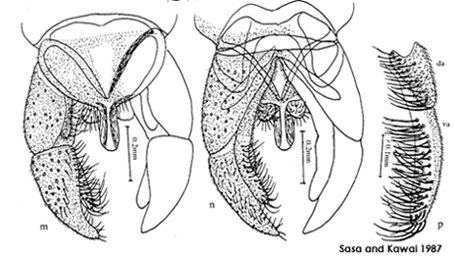|
Chironomus (Camptochironomus) biwaprimus Sasa Adult (from Sasa & Kawai 1987) Length 6.96-8.11; wing length 3.58-4.05; VR 1.02-1.06. AR 3.17-3.89 LR: Ant. 1.34-1.58; mid 0.50-0.56; hind 0.58-0.64. BR 1.6. Coloration unusual - antennal shaft brown, hairs brownish yellow; ground color of scutum greenish yellow or pale yellow, vittae dark brown; legs with femur and tibia largely yellow with a narrow apical dark ring; tarsi darkening from brown to dark brown. Head with relatively small frontal tubercles 22 micron long, 14 micron wide. Thorax: Antepronotum united and expanded in the middle, without lateral setae. Setae: Acrostichal 6-14; dorsolateral 19-36; prealar 6-10; scutellar 24-36 in a double row. Legs: Front tibia with 4 subterminal setae arising on a rounded terminal scale.  Fourth instar larva: A moderate sized, up to 20mm, plumosus-type larva. Lateral tubules well developed, about 300 µm long. AT nearly as long as the posterior prolegs and are constricted in the middle, about 2.5-2.7 times longer than wide. Gula dark on posterior half, frontoclypeus dark, particularly towards the rear. Cytology: Four polytene chromosomes with the Camptochironomus cytocomplex combination AB, CF, DE, G. Specimens available did not have particularly good chromosomes, but some banding patterns could be determined. Arm G may have a nucleolus but main nucleolus is in a long chromosome, probably near the centromere of the AB chromosome. One heterozygote, probably in arm B. biwA1:biwB1: biwC1: biwD1: biwE1: 1 - 2b, 7h - 10b, 3e - 2c, 7g - 3f, 10c - 13 i.e. as dilutus E1 biwF1: possibly 1a-d, 12-9b, 2f-3b, 13-14c, 5d-6, 9a-7a, 14d-16, 5c-3c, 1e-2e,.17-23 biwG1: Found: Type locality - Lake Biwa (35.33°N, 136.17°E), Honshu, JAPAN; Lake Kasumigaura (36.42°N, 140.39°E); NEIS, Tsukuba (36.08°N, 140.08°E), Yatabe, Ibaraki. |
Modifieded: 2 January 2023
Access: Unrestricted
Copyright © 2010-2023, Jon Martin.